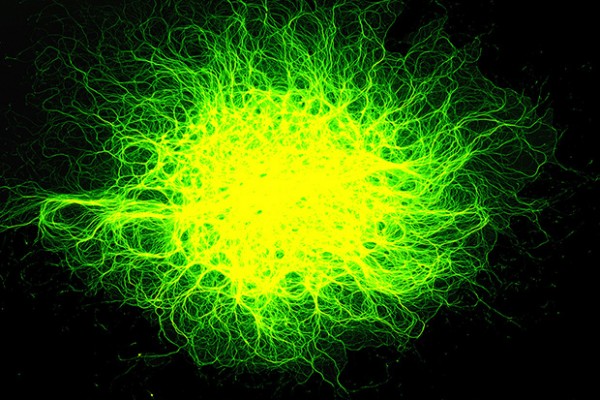Scientists identify clue to regrowing nerve cells
School of Medicine researchers have identified a chain reaction that triggers the
regrowth of some damaged nerve cell branches, a discovery that one day may help improve treatments for nerve injuries that can cause loss of sensation or paralysis. To study how nerve cells respond to injuries in their branches, researcher Valeria Cavalli grows them in “spots,” like the one pictured.
Some brain cells are better virus fighters
Viruses often spread through the brain in patchwork
patterns, infecting some cells but missing others. New research at the School of Medicine helps explain why: Natural immune defenses that resist viral
infection are turned on in some brain cells but switched off in others. The white arrows in the picture highlight infected cells in a mouse brain.
Sensitivity to alcohol affected by genes active in neurons
In these brain sections of neonatal mice exposed to ethanol, mice deficient in certain enzymes (right) exhibit much more neurodegeneration as indicated by the black material in the dying neurons.Can you blame your genes if you can’t handle your liquor? A new study conducted at the School of Medicine may pave the way to finding out. Researchers found that the brain’s response to alcohol is partially under the influence of two genes. The genes, studied in both adult and newborn mice, were found to affect sensitivity to alcohol intoxication, interest in alcohol consumption and risk of developmental brain damage from alcohol.
Sensitivity to alcohol affected by genes active in neurons
In these brain sections of neonatal mice exposed to ethanol, mice deficient in certain enzymes (right) exhibit much more neurodegeneration as indicated by the black material in the dying neurons.Can you blame your genes if you can’t handle your liquor? A new study conducted at Washington University School of Medicine in St. Louis may pave the way to finding out. Researchers found that the brain’s response to alcohol is partially under the influence of two genes. The genes, studied in both adult and newborn mice, were found to affect sensitivity to alcohol intoxication, interest in alcohol consumption and risk of developmental brain damage from alcohol.
Nervous system ‘ears’ line up across from ‘mouths’
Neurons communicate at a synapseAs the nervous system develops early in life, it must create millions of synapses—small spaces between nerve cells across which the cells can communicate. Scientists have long speculated that these synapses are deliberately organized to place the structures that send messages on one cell directly across from the structures on another nearby nerve cell that receive those messages. School of Medicine researchers have provided the first experimental proof of this theory at the level of the nervous systems’ most fundamental unit: individual clusters of structures that send and receive signals.

